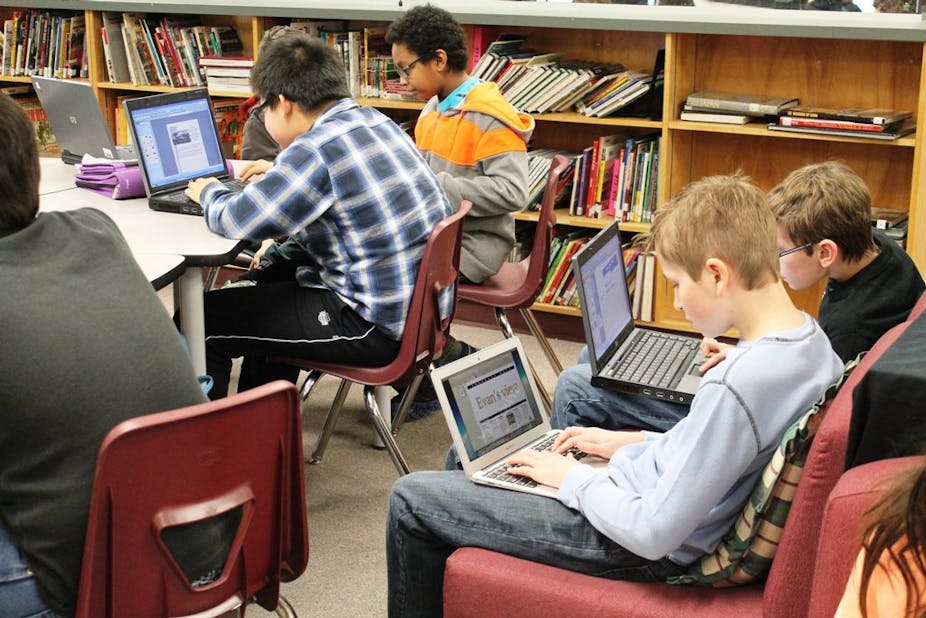As schools struggle with shortfalls in their digital technology budgets and as teachers see how much parents spend on laptops and tablets at home, many teachers are considering letting pupils bring their own devices to class. This raises questions about whether parents should be expected to contribute directly to the cost of technology in schools, and whether asking children to bring in their own devices is an appropriate strategy.
In England, where every child has the right to a free education, schools are still experimenting with whether or not every child should have a mobile device. Based on research carried out in 22 English schools the question being asked seems to be: “Is it right to expect parents to pay anything towards the cost of digital technology for use in school?”
But in Australia, there seems to be a general assumption that every child should have their own mobile device in school. Based on data from 13 schools that I visited in five states in Australia in 2013, there seems to be an expectation that the only way to sustain every child having their own mobile device is to require parents to pay for them.
Free laptops were supplied to high school students under the last Labor government in Australia, but funding for that programme ceased in 2013.
The question now being asked in Australia is: “What is the best model of provision and how much can we expect parents to pay?” This is in a context where most parents are used to being asked to pay something towards their child’s education, in addition to taxes, even if their child goes to a state school.
Keeping up with the Joneses
In both countries there are concerns about equity issues and disadvantaging those children whose parents cannot (or will not) pay for digital technology. But you could also argue that all students benefit if you increase the overall amount spent on digital technology, and focus the school’s funding on those students who come from more disadvantaged homes.
The funding models that were evident in the English and Australian schools spanned the full range. Some schools funded all the technology themselves, others asked parents to contribute through an annual charge or monthly leasing scheme payment over two or three years. Other parents are being expected to provide their child with a specific specification of device, which I call “buy your own”. And some schools just let children bring their own digital technology, no matter what make or model – “bring your own”.
The important distinctions between “buy” and “bring” your own were often lost on schools. Specifically, the buy your own model places an expectation on parents to provide a device, often one that meets a particular school specification.
Asking children to bring their own device, in contrast, simply allows them to use something that you already to have. Buy your own often requires the parent to go out and buy a specific device, whilst bring your own does not.
Bring your own often won’t result in every child having a device, and would almost certainly mean that a range of devices were being brought in. Most schools in both England and Australia seem to assume that it is better and easier for the teacher if every child has a device, and that all the devices have the same specification. So they prefer buy, to bring your own.
Why not ask parents?
One of the surprising things we found in most of the schools that we visited in both England and Australia was that they didn’t have a clear picture of what devices students already had access to at home. In several of the Australian schools this resulted in students having their own laptop and/or tablet, plus the school laptop or tablet that their parents had been asked to pay for.
In order to help address this problem we have developed a service for schools, called Your Own Technology Survey (YOTS), which helps schools to audit their students’ access to the internet.
Early analysis of data for 3,341 students in Years seven to 13 across 23 schools in England, collected in 2013, suggests that a significant proportion of students have access to an internet-enabled mobile device at home. And crucially, that they would be allowed, able, and willing to bring it to school on a regular basis. This varied between devices: 75% of respondents said they would be allowed, able and willing to bring in a smartphone, compared with 30% for a laptop, and 19% for a tablet.
Perhaps it is time for schools to rethink their digital technology strategies, based on actual data about what equipment their students have access to at home, which they could use in school.

